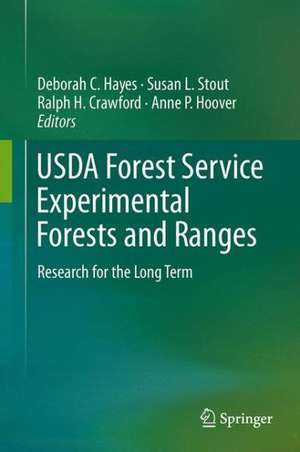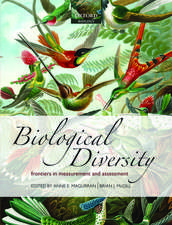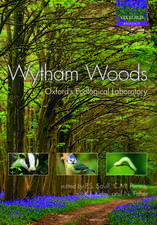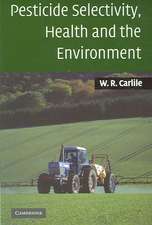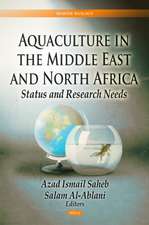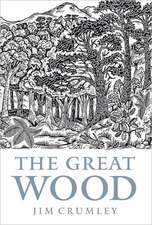USDA Forest Service Experimental Forests and Ranges: Research for the Long Term
Editat de Deborah C. Hayes, Susan L. Stout, Ralph H. Crawford, Anne P. Hooveren Limba Engleză Hardback – 23 iul 2014
| Toate formatele și edițiile | Preț | Express |
|---|---|---|
| Paperback (1) | 1235.57 lei 6-8 săpt. | |
| Springer – 24 sep 2016 | 1235.57 lei 6-8 săpt. | |
| Hardback (1) | 1242.03 lei 6-8 săpt. | |
| Springer – 23 iul 2014 | 1242.03 lei 6-8 săpt. |
Preț: 1242.03 lei
Preț vechi: 1514.68 lei
-18% Nou
Puncte Express: 1863
Preț estimativ în valută:
237.65€ • 248.16$ • 196.25£
237.65€ • 248.16$ • 196.25£
Carte tipărită la comandă
Livrare economică 15-29 aprilie
Preluare comenzi: 021 569.72.76
Specificații
ISBN-13: 9781461418177
ISBN-10: 1461418178
Pagini: 696
Ilustrații: XXII, 672 p. 187 illus., 105 illus. in color.
Dimensiuni: 155 x 235 x 43 mm
Greutate: 1.14 kg
Ediția:2014
Editura: Springer
Colecția Springer
Locul publicării:New York, NY, United States
ISBN-10: 1461418178
Pagini: 696
Ilustrații: XXII, 672 p. 187 illus., 105 illus. in color.
Dimensiuni: 155 x 235 x 43 mm
Greutate: 1.14 kg
Ediția:2014
Editura: Springer
Colecția Springer
Locul publicării:New York, NY, United States
Public țintă
GraduateCuprins
Part I. Introduction.- Deputy Chief of FS Research, Raphael Zon, Memo to Forest Service Chief Pinchot, May 6, 1908.- Map of USDA Forest Service Experimental Forest and Ranges.- Chapter 1. A Grand Experiment: USDA Forest Service Experiment Forest and Ranges.- Chapter 2. Forest Service Experimental Forests and Long-term Data Sets: Stories of their Meaning to Station Directors.- Part II. Research Trajectories in Forest Ecology, Management, and Silviculture for Conifers.- Chapter 3. The Value of Old Forests: Lessons from the Forest Service Reynolds Research Natural Areas.- Chapter 4. Restoring a legacy: Long-leaf pine research at the Forest Service Escambia Experimental Forest.- Chapter 5. Northern Conifer Research: Multiple Species and Multiple Values.- Chapter 6. Fire and Thinning Research on Forest Service Blacks Mountain Experimental Forest.- Part III. Research Trajectories in Forest Ecology, Management, and Silviculture for Hardwoods.- Chapter 7. Uneven-aged management after a half-century of research on the Forest Service Fernow Experimental Forest in West Virginia.- Chapter 8. An Alternative to Clearcutting: A Partnership between Scientists on the Fernow Experimental Forest and Land Managers on the Monongahela National Forest.- Chapter 9. Development of the Selection System in Northern Hardwood Forests: An 80 Year Research Legacy with Impacts across Borders.- Part IV. Research Trajectories in Wildlife, Fauna, Insects.- Chapter 10, The Starkey Experimental Forest and Range: Long-Term Research to meet the needs of Managers.- Chapter 11. Evolution of a Short-Term Study of Lodgepole Pine Dwarf Mistletoe Vectors that turned Into a Long-Term Study of the Remarkable Gray Jay on the Fraser Experimental Forest, Co, 1982-2009.- Chapter 12. Subterranean Termite Control Examinations on Current And Former Experimental Forests and Ranges.- Part V. Research Trajectories in Forest and Range Hydrology, Biogeochemistry,Soils and Ecosystem Science.- Chapter 13. A Cycle of Research at Fort Valley, Arizona, the First Forest Service Research Experiment Station.- Chapter 14. Contributions of Studies on Experimental Forests to Hydrology and Watershed Management.- Chapter 15. A History of Watershed Research in Experimental Forests of the Interior Highlands.- Chapter 16. Research Related to Roads in USDA FS Experimental Forests.- Chapter 17. The Role of Experimental Forests and Ranges in the Development of Ecosystem Science and Biogeochemical Cycling Research.- Chapter 18. Six Decades of Soil and Ecosystem Research at USDA FS Calhoun Experimental Forest.- Chapter 19. Disturbance Ecology and Tropical Forest Management at the Luquillo Experimental Forest.- Chapter 20. The Acid Deposition Trajectory.- Part VI. Research Trajectories in Fire.- Chapter 21. From Fighting Bad Fires to Fire-Dependent Ecosystems.- Chapter 22. The Fire Research Program at the Silas Little Experimental Forest, New Lisbon, New Jersey.- Part VII. Intersite and Network Trajectories.- Chapter 23. The Key Roles of Four Experimental Forests in the Long Term Soil Productivity International Research Program.- Chapter 24. The Role of the Hydro Database in Developing the Water Hydrology and Chemistry Network.- Part VIII. Emerging Human Dimension Research Trajectories.- Chapter 25. Social Science Research and Experimental Forests and Ranges.- Chapter 26. Public Use and Citizen Outreach in Experimental Forests and Ranges.- Chapter 27. Expanding the Vision of Experimental Forests to Urban Areas.- Part IX. The Future.- Chapter 28. The Future of USDA Forest Service Experimental Forests and Ranges.
Recenzii
“This book provides an extensive summary of these facilities. There is an overview of each facility, including history, accomplishments, major research/contributions, and experimental findings. … Summing Up: Recommended. Graduate students through professionals/practitioners.” (D. H. Pfister, Choice, Vol. 52 (9), May, 2015)
Notă biografică
At the time of writing, the Editors are all scientists with the USDA Forest Service in Research and Development Mission Area. Drs. Deborah C. Hayes, Ralph C. Crawford and Ann P. Hoover are National Program Leaders in Ecosystem Science, Rangeland Science and Social Science, respectively. They are located in the Forest Service Headquarters in Washington D.C. Dr Susan L. Stout is a Project Leader and Research Silviculturist with the Forest Service Northern Research Station in Irvine, PA.
Textul de pe ultima copertă
Long-term Forest Service research studies are the source of ideas, tools and research methods that we now take for granted. These range from the effects of fire exclusion on forest and rangeland structure and composition through modern tree care and vegetation control. Innovative experimental designs, such as the use of paired watersheds to understand the effects of forest management on water quality and quantity, were developed on USDA Forest Service Experimental Forests and Ranges (EFRs). The stories of these and other innovations are told in this volume.
EFRs are scientific treasures, providing secure, protected research sites where complex and diverse ecological processes are studied over the long term. This book offers several examples of the dynamic interactions among questions of public concern or policy, EFR research, and natural resource management practices and policies. Often, trends observed – or expected -- in the early years of a research program are contradicted or confounded as the research record extends over decades. The EFRs are among the few areas in the US where such long-term research has been carried out by teams of scientists. Changes in society’s needs and values can also redirect research programs. Each chapter of this book reflects the interplay between the ecological results that emerge from a long-term research project and the social forces that influence questions asked and resources invested in ecological research. While these stories include summaries and syntheses of traditional research results, they offer a distinctly new perspective, a larger and more complete picture than that provided by a more typical 5-year study. They also provide examples of long-term research on EFRs that have provided answers for questions not even imagined at the time the study was installed.
EFRs are scientific treasures, providing secure, protected research sites where complex and diverse ecological processes are studied over the long term. This book offers several examples of the dynamic interactions among questions of public concern or policy, EFR research, and natural resource management practices and policies. Often, trends observed – or expected -- in the early years of a research program are contradicted or confounded as the research record extends over decades. The EFRs are among the few areas in the US where such long-term research has been carried out by teams of scientists. Changes in society’s needs and values can also redirect research programs. Each chapter of this book reflects the interplay between the ecological results that emerge from a long-term research project and the social forces that influence questions asked and resources invested in ecological research. While these stories include summaries and syntheses of traditional research results, they offer a distinctly new perspective, a larger and more complete picture than that provided by a more typical 5-year study. They also provide examples of long-term research on EFRs that have provided answers for questions not even imagined at the time the study was installed.
Caracteristici
Offers several examples of the dynamic interactions among questions of public concern or policy, EFR research, and natural resource management practices and policies This book examines research trajectories emerging from the body of work conducted on EFRs over their first century of service Explores the continued promise of long-term research on EFRs and new ways of using the network of EFRs to answer today’s science questions Includes supplementary material: sn.pub/extras
